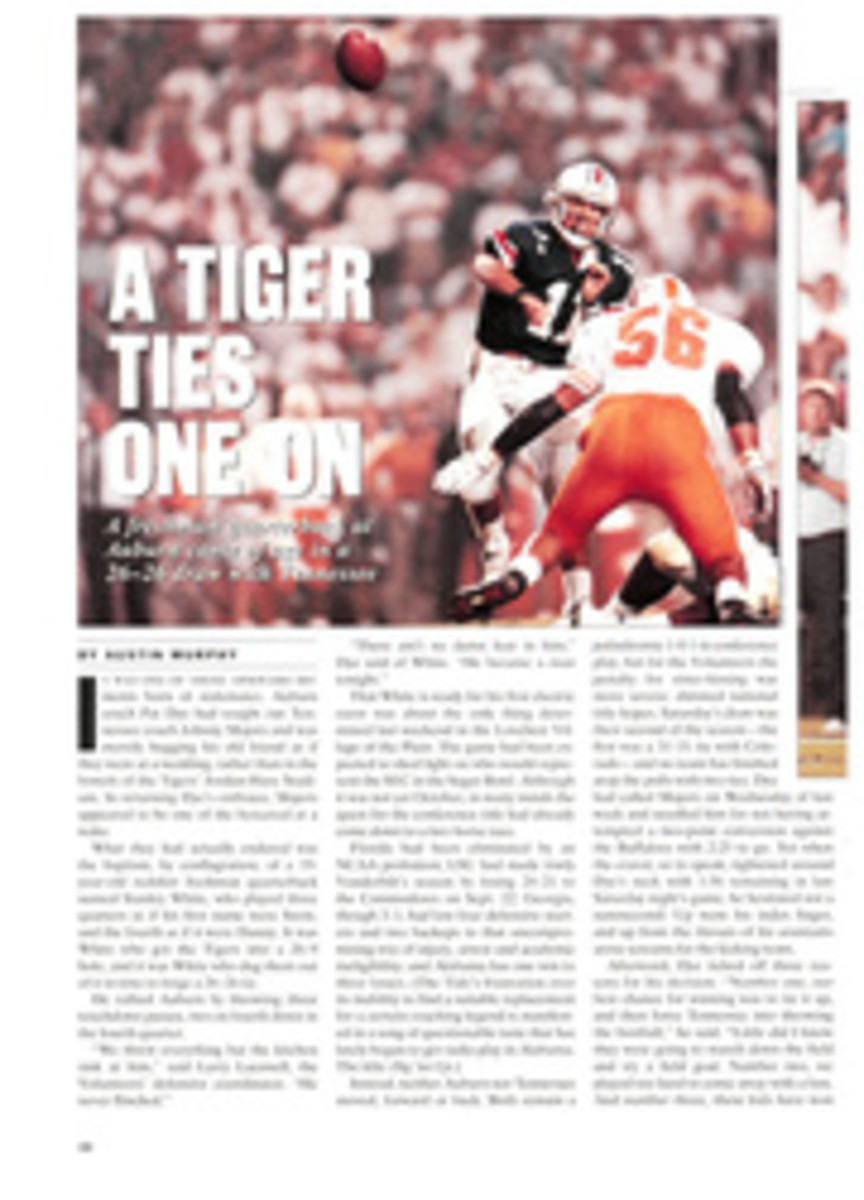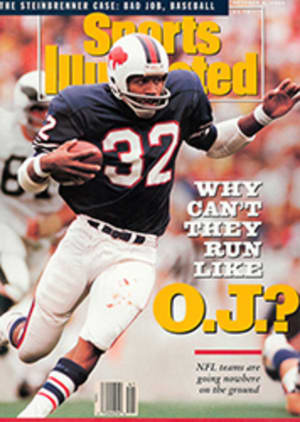
FOR HOCKEY FANS THE PUCK STARTS HERE
We cherish some sporting gear: the baseball glove anointed with oils, golf clubs hooded under monogrammed cozies, the handmade, ebony-inlaid, two-piece pool cue caressed with expensive waxes.
But nobody loves the hockey puck. Even the name is cold and hard. Puck: breaker of teeth, blackener of eyes, an obsidian villain that at best evokes indifference from Moose Jaw to Minnetonka. It may sound friendly in French—la rondelle—but even in Quebec, hockey's gelid Garden of Eden, no one thinks much of, or much about, the game's object of contention. Is there nothing, then, to say for this neglected disk? On the contrary.
Ice hockey developed from folk games played in the British Isles and France with balls made of wood or cork. Called hocquet in France, hurley in Ireland, bandy in England and shinny in Scotland, these types of field hockey intersected in 19th-century Canada's French and English culture and were relocated to ice. Today the sport's bucolic roots are reflected in the term shinny hockey, the informal version of the game in which anything handy—a chunk of wood, a shard of ice, a clod of frozen horseplop—will serve as the smackable center of attention.
There is some debate over when the first ice hockey game was played, and the genesis of the modern puck is equally uncertain. But hockey lore holds that the first disk took shape in the 1880s when the proprietor of the Victoria Skating Rink in Montreal sliced off the top and bottom of a solid rubber ball, so it would slide rather than bounce across the ice.
Most of the pucks found in sporting-goods stores are Czechoslovakian-made cheapies. But virtually all game pucks used in the National, American, Western, Ontario and Quebec Hockey Leagues, and many of those in collegiate play, are made for In Glas Co Ltd. of Sherbrooke, Que., at the Baron Rubber Ltd. factory in St.-Jèr‚Äö√†√∂¬¨•me, 20 miles north of Montreal.
Light and dark amber blocks of natural and synthetic rubber are the basic ingredients from which pucks spring. Following an industrial recipe, a technician loads the spongy slabs of raw rubber (at a 1:9 ratio of natural to synthetic material) into the bin of a machine called a Banbury. The operator also pours in an activator, a chemical agent such as sulfur, that affects how quickly the rubber will cure. Carbon black, which gives the mixture color and influences the chemical reaction, and oils, which also help in the mixing process, are added to the conglomeration, which is then blended by two large rotor blades.
After being thoroughly mixed for about four minutes, the hot, 65-kilogram glob drops out of the bin onto motorized rollers, which squeeze out bubbles and flatten the wad. The resulting sheet is then cut off the rollers, rolled up and cooled in a bath. Samples are taken to ensure that the batch will produce a rubber of the desired hardness, resiliency and density. When the lab gives the go-ahead, the rolled sheets of rubber are loaded into another machine, called a Barwell, which produces the blanks from which the pucks will be molded. The Barwell pushes the rubber through holes that admit the precise amount of material needed to form each one-inch-thick, three-inch-diameter, six-ounce puck. The blanks then move on a conveyor belt through a refrigerated compartment, which slows the curing process before final molding.
Top-grade pucks are injection-molded out of virgin—first-use, nonrecycled—compound. Less expensive practice pucks are compression-molded and, typically, are made from cheaper grades of rubber or recycled material, such as ground-up automobile tires, as filler. The injection process results in a higher degree of precision in the puck specifications than does compression. But whether they begin life as virgin compound or "tire crumb," the blanks go into molds and are baked at 365° F for six minutes for injection-molding, or 11 minutes for compression-molding. A tread, called a knurling, is imprinted by the mold onto the puck's circumference to allow for better stick-handling. At peak production, the Baron factory can turn out 12,000 pucks daily.
Once they've been rolled, squeezed and cooked into existence, pucks are popped out of the molds and packed in wooden crates, 5,760 to a crate. Those destined for NHL action go to the In Glas Co facility in Sherbrooke, where the league logo is silk-screened on one side, team emblems on the other. In Glas Co sells game pucks to individual NHL clubs for about $1 apiece in boxes of 100; practice pucks cost about 65 cents each.
NHL clubs store game pucks in freezers to deaden their bounce. During games, two or three dozen are kept on hand at the scorer's table. Denis Drolet, In Glas Co's president, says each NHL team buys about 5,000 game and 10,000 practice pucks a year, which means the league as a whole goes through more than 100,000 game pucks and 200,000 unadorned practice disks.
Little has changed about the puck since its dimensions were formalized more than 100 years ago. And although beholding a crate of 5,760 identical rubber disks is to understand that a puck is a puck is a puck, some have stood out from their vulcanized brethren. A few have even earned a place in the Hockey Hall of Fame, run by the NHL in Toronto, such as the three pucks that were used in the fastest hat trick in NHL history (21 seconds, by Chicago Blackhawk Bill Mosienko on March 23, 1952); the star-crossed disk that stayed in play for an entire game between the Los Angeles Kings and the Minnesota North Stars on Nov. 10, 1979; the one carried aboard the space shuttle Challenger by a Canadian astronaut in 1984. There is even a 104-year-old square puck in the International Hockey Hall of Fame in Kingston, Ont., used in an 1886 game between Queens University and the Royal Military College, both of Kingston.
For the true connoisseur de la rondelle, Fotopuck (made by Fotoball USA, Inc. in San Diego) and Star Puck (made by Star Puck Inc. in Pickering, Ont.) are perfect for desk or mantel enshrinement. The rival products feature printed color photos of top players like Brett Hull, Mario Lemieux and Wayne Gretzky. The basic Fotopuck retails for $12; a limited-edition model autographed by the Great One himself is available for $199. Star Puck sells for $8; a special Lanny McDonald Star Puck costs $12.95, with part of the proceeds going to the Special Olympics.
In the AHL, a Maine Mariners fan struck by a stray puck used to be awarded membership in the Loyal Order of the Unducked Puck, which included a commemorative puck embedded in Lucite. But the practice was ended a few years ago after a prospective recipient, who had been knitting at the time she was hit, "took the cotton out of her mouth long enough to tell me what I could do with my consolation prize," says Mariners president Ed Anderson.
Anyone who has ever tasted a moving puck can attest to its solidity. And while all pucks are supposedly created equal, some have proved to be more equal than others. In the minors last season, Plexiglas panels were being broken by pucks in unprecedented numbers. The Maine Mariners had to replace 24 of them, at $200 to $300 per. The Adirondack Red Wings replaced 18 panels, the Cape Breton Oilers 11, and the Flint (Mich.) Spirits 10. The Rochester Americans suffered 18 broken panels. The common denominator turned out to be In Glas Co's pucks, which when sliced open revealed what looked like tiny flecks of metal inside. In Glas Co replaced the suspect pucks, and the problem seemed to clear up.
So how did the metallic flakes get in there? Drolet says only that there was an unspecified problem with the compound, but Don Waddell, then general manager of the now-defunct Spirits, theorizes that the lively pucks may have contained filler from old steel-belted tires.
In 1972 the World Hockey Association tried a painted red puck that would be easier to see on TV and might give the fledgling league a distinctive flair, along the lines of the old ABA red-white-and-blue basketball. Blue, orange and green paints were tried also, but the paint came off under game conditions. Plastic coatings worked well but were too costly. Dyes were tried but faded or caused the puck to warp. The last effort, a dye-job dubbed Superpuck Blue, held color and shape in tests and was introduced at the beginning of the 1972-73 season. But players, goalies in particular, complained that Super Blue got mushy and bounced unpredictably late in the game. The colored puck went nowhere, as did a proposal calling for a puck embedded with an electronic device that would appear on TV screens as a small red arrow.
The NHL doesn't plan to tinker with the basic puck, which suits goaltenders just fine. To them black is beautiful, and the blacker the better. Andrè Blanchette, In Glas Co's plant manager, says some goalies even complain about the white background that the team logos are printed on. As the most active knights in the Order of the Unducked Puck, netminders deserve a voice on the subject. And black—mysterious and serious—seems the appropriate color for that overlooked, undersung object at the center of the world's fastest game. Vive la rondelle!
PHOTO
BILL BALLENBERG
(1) A rubber concoction is mixed in a Banbury.
PHOTO
BILL BALLENBERG
(2) Rollers flatten the hot rubber.
PHOTO
BILL BALLENBERG
(3) Blanks are cured and then baked in a mold at 365°F.
PHOTO
BILL BALLENBERG
(4) Fresh from the oven, the pucks are almost ready.
PHOTO
BILL BALLENBERG
(5) Islander pucks receive a final inspection.
Jack Mason is a writer for Time Inc. Magazines' in-house newsletter.

